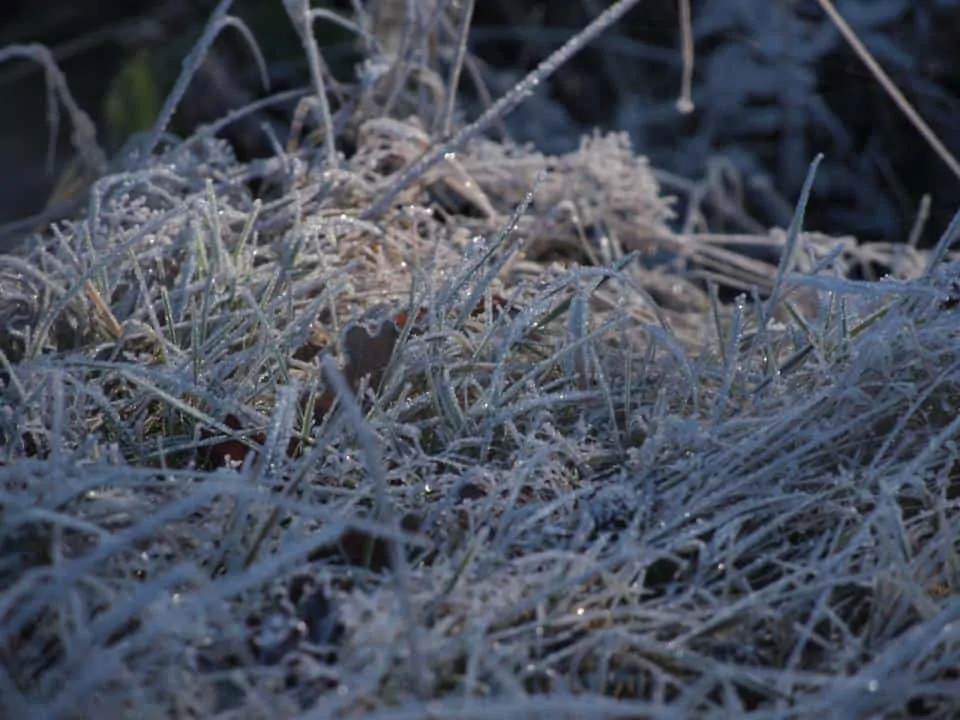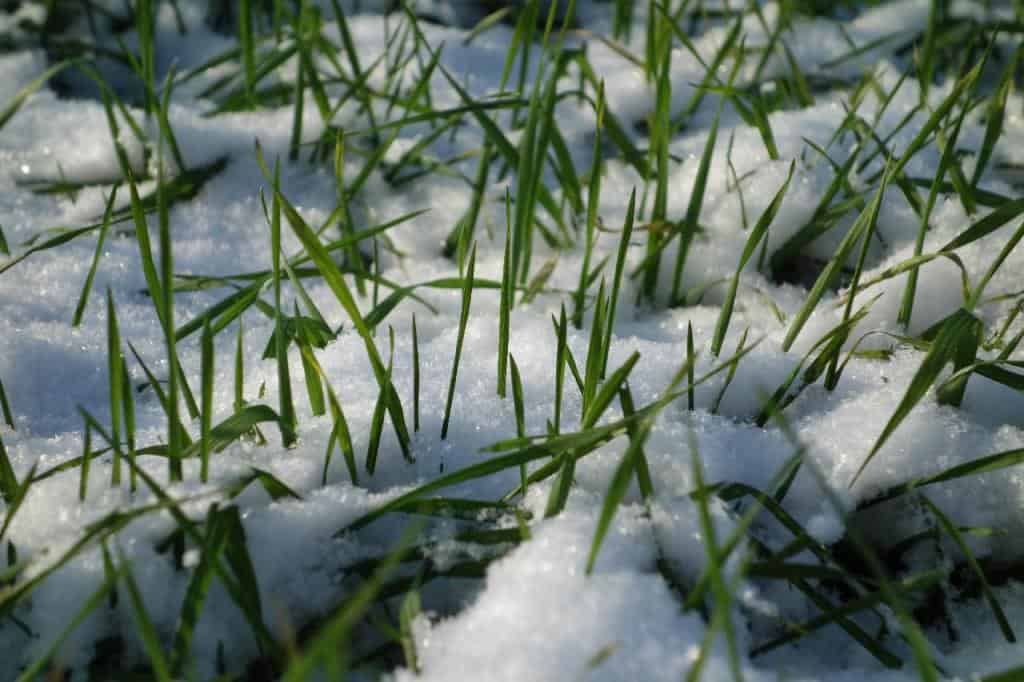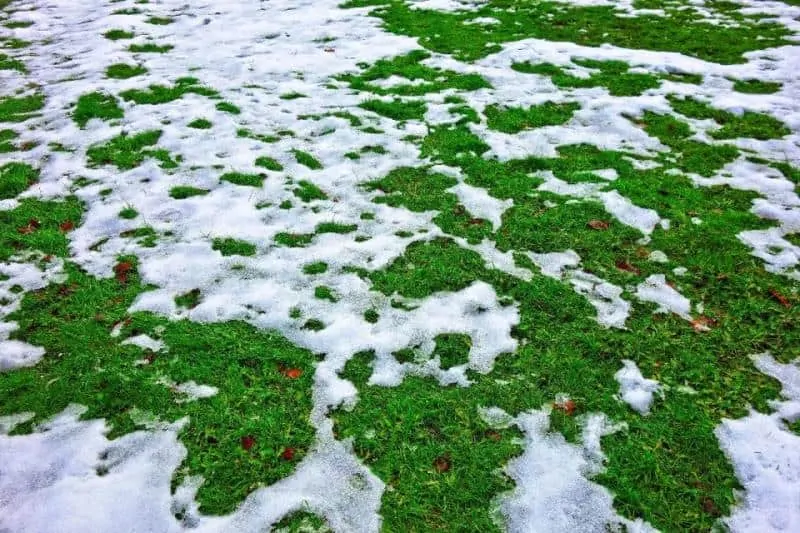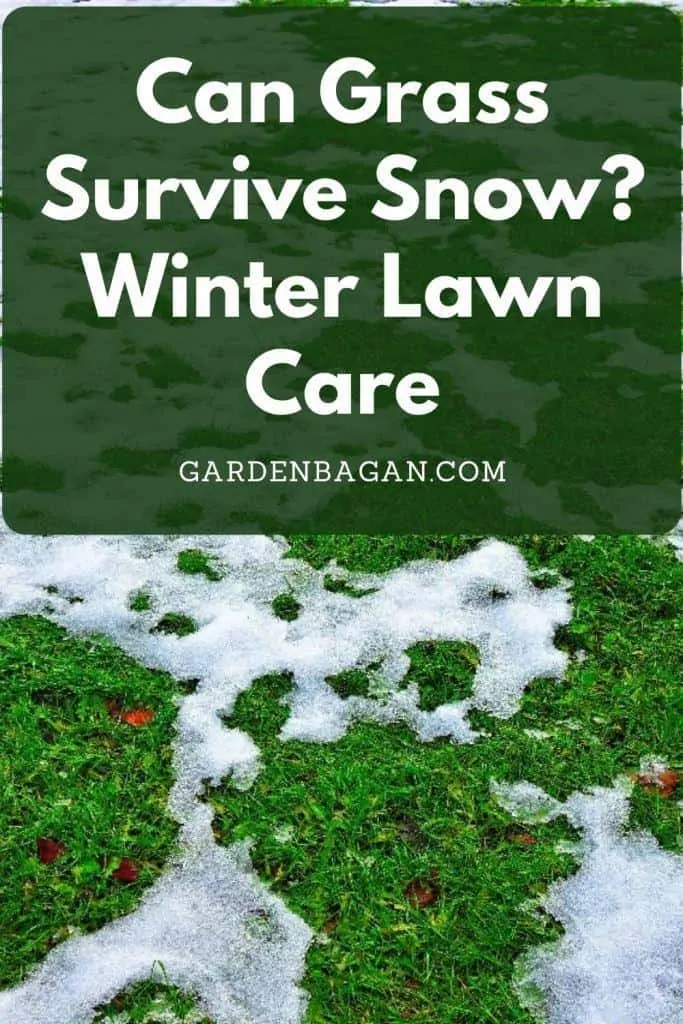Can Grass Survive Snow?- Most of the perennial varieties of Grass can easily survive the snow. Their leaves or blades can fall and new leaves grow back again during spring. These varieties can easily propagate through their roots. The Annual grass varieties, on the other hand, cannot survive like this. Instead, they spread their seeds before frost and they die. In spring these seeds get germinated and grow back into new grasses.
Check out How to Grow Sweet Potato Vine Easily?
What happens to grass when it snows?
The grass is one of the most invasive plants on earth. There are more than 1000 different varieties of grass found worldwide. They are found everywhere, from desert to high hill areas. Still, they have some limitations. The grass is not immune to frostbite. It can not survive frost or heavy snow without being damaged.
It is perfectly natural but Do you know?- What exactly happens to the grass when it snows?
- The most common reaction is seasonal dormancy to survive winter kill. The Grass Plant reduces all its metabolic activity to save energy and resources during snowy winter. It can even recycle the chlorophyll to survive the harsh climate.
- Most of the cold region grass has developed a natural antifreeze mechanism. This natural mechanism initiates during early winter. Gradual Reduction in daylight triggers this mechanism. It prepares the grass to survive during heavy snow and frost.
- The Grass will lose water and get a state of partial dehydration. This reduction in water will increase the mineral concentration in cellular fluids. The increase in mineral concentration acts as an antifreeze during winter. This prevents the liquid in the cells from freezing, ultimately prevents the grass from dying.
- During snow, the grass stops any unnecessary growth like root or leaf development. Instead, it saves all its precious resources to save the main root and nodes. New plants will develop from these roots and nodes in the spring season.
What is winter kill?
Any severe damage to the grass that can kill it during winter is called Winter kill. Winter kill is prominent in frost-prone areas. USDA Zones 5-8 is affected by winter kill especially to turfgrass and other lawn grass.
If you live in any frost-prone region like Canada, Some parts of North America, Most of Europe or Nothern parts of Asia then you may have faced winter kill in your garden. This is a natural process and can not be avoided. Instead, you can minimize the effect by planing for worst before winter.
Most professional gardeners and lawn managers follow a 2 step Procedure to handle this situation. First, they prepare and second they execute after any damage.
Before proceeding we should first check for the extent of damage in your region. Every zone in different so make sure your lawn is affected by winter kill or not. So how to do that? keep reading.

How to identify winter kill in the grass?
There are three ways to identify winter kill in Grass.
- Check for brown patches in the lawn grass just after first or second snowfall. Any brown patch after initial snowfall is a symptom of winter kill. This method is effective if you experience a moderate amount of snowfall in your area. You can not see anything under snow cover so it is useless during heavy snow.
- Remove some snow carefully from a small area and place a transparent plastic sheet over it. Leave it like this for 2 days. If you notice any new grass coming out then it is fine else it may have affected by winter kill. Note that this method is not recommended for beginner or home gardeners. This method can easily damage the patch of grass you are testing. So try only if you are sure about the procedure and effects. This method is recommended only if your experience frost for more than 45 days.
- Just wait for the snow to melt. Most of the grass will start growing within 2-3 weeks. Checkout for blank patches and dead spots to identify the winter kill over lawn grass. It is the easiest method. You can not do anything for prevention in this method. Instead, you can act for rapid recovery if you want.
Also read: How to Kill Grass Burrs? get rid of southern sandspur
How much cold, grass can Survive?
The grass is considered a very hardy plant. It is tolerant to low to very high temperatures. In general, the safe temperature range for grass is 50-85 F(8-45 C) or even more. Most of the grass varieties can easily survive cold winter to short summers. Meanwhile, they love heavy monsoon or rainy season.
Some colder varieties of grass can even survive temperatures below 40 degrees Fahrenheit.

Can Grass seed Survive Snow?
Most probably it can. The tiny grass seeds are highly protected for any natural factors. In cold snow like condition, the grass seeds get into dormant condition and avoid any germination.
This dormancy can last for more than 2-3 months. The grass seed can easily survive the dormant state under the snow.
These seeds will germinate in the spring when the temperature rises above 60 degrees Fahrenheit.
Do you Know?- The seeds of some desert grass can stay in format state for more than 3 years.
Can You Plant Grass Seeds in the snow?
First of all, you should understand that grass seeds will not germinate in snow. Snow is the most hydrophilic substance in this situation. So, there will be no moisture available for the seed to germinate. The temperature is also not suitable for seed germination. Finally, the seed will stay in dormancy to stay safe.
So does it mean you can’t grow grass seed in the snow?
Yes, at some point it does. You most probably cannot grow grass in snow but you can plant the seeds. You can sow grass seeds in empty patches to fill the spot. The snow will help the seeds to root firmly in the soil before germination.
Early lawn preparation is the biggest advantage of sowing grass seeds in the snow.
Problems With Grass During Snowy Winter?
The problems with grass during winter are collectively known as winter kill. There are two types of winter kill- Biotic factors and abiotic factors.

The biotic form of winter kill problem includes animals, insects, pests, and all living factors. Three main biotic winterkills are – Voles, Mice, Wild hogs. Sometimes deer and molds also act as biotic forms of winter kill for lawn grass. Any damage done on grass due to animals can be treated as biotic winter kill.
Voles & Mice
Voles, garden mice, and sometimes wild boars or hogs can damage the grass carpet. Especially during early winter the grass slows down its growth and saves all resources in the root nodes. The grass root is a rich source of carbohydrates for underground dwellers. Boars or hogs dig the soil and uproot the grass to eat their roots.
These animals are very harmful to carpet lawn grass. You can identify the damage done by boars or hogs. Everything will look damaged. On the other hand, the damage done by voles or mice looks like thin trails of dead grass. These underground dwellers eat the roots of grass leaving a trail of dead grass on the surface.
You can control hogs by proper fencing using metal nets & live wires. Try Using skilled cats to get rid of voles or mice. Don’t worry if they fail then try some distractions to keep them away from your lawn.
Molds
The snow cover can protect the grass from wild winter winds. The excess of moisture and protection can help molds to grow under the cover. This fungus can kill the grass and occupy the space. You cannot do anything to avoid these molds, but you can remove them in spring.
These molds can not survive the direct sunlight so just wait for a warm spring morning. Meanwhile, you can clean and remove the brown-green molds on your own.
The lawn can indeed get blank dead patches due to molds. The only thing you can do is reseed grass and wait for a few weeks to see if it worked. The grass will cover the patch within a month or so.
How do you get rid of the fungus in the garden soil?
Abiotic Winter Kill
All non-living or abiotic factors that lead to winter kill are the main problem during snowy winter. The Damage done to the grass due to natural abiotic factors during winter is called Abiotic winter kill.
Four abiotic factors are considered as winter kill for turfgrass.
- Desiccation
- Direct low-temperature kill
- Ice encasement
- Crown hydration
Cold Desiccation
The desiccation due to heavy cold is common with susceptible grass varieties grown in elevated lands. It is a very common problem when the temperature gets low without any snowfall.
The exposed grass rapidly loses moisture due to wind chill. This leads to severe damage to the crown tissues which is responsible for leaf and root growth. Prolonged cold desiccation can kill the grass and leave a blank dead patch on the soil.
Technically you can not do anything to stop cold desiccation but at least you can avoid it to some extent.
- You can use some windshield to protect your lawn from heavy cold winds. Try using sand or fabric covers to protect the grass crowns from cold wind. This is effective only in a small area. You cannot do anything for large open ground.
- Instead, grow some cold-tolerant varieties of grass. These grass varieties are genetically acclimatized to harsh cold climates. Though some cold season varieties and Bluegrass are also susceptible to winter desiccation.
- Avoid excess watering from early winters. This slow dehydration technique greatly helps the grass to attain dormancy before frost.
- Once damaged reseeding is the only option you can try. Always select good quality adaptable varieties of grass for growing in lawns.
Direct low-temperature kill
Another problem with grass during winter is direct low-temperature kill. This problem is similar to cold desiccation with some changes. In fact, Here the sudden temperature change acts as a key factor for damaging the grass, not the cold wind.
This happens in regions with severely cold winters. With the reduction in normal daylight during winter, the grass starts dehydrating its leaves and stems to increase the fluid concentration. This makes then hard enough to survive during cold winter. This acclimatization procedure is triggered by a gradual drop in temperature and daylight.
Now if the temperature drops in early winters and increases again in the falls. Then the acclimatization gets slow down. The grass cannot prepare itself in time to survive the cold. Hence it will die.
The change in temperature is the main reason for the direct low-temperature kill. The natural acclimatization is a time taking procedure. It is governed by a gradual drop in temperature. So if the temperature falls or rises quickly during winter then grass can not survive.
Again you cannot alter with natural phenomena. Just give some shade or cover if you can to increase the soil temperature. This is all you can do to avoid direct low-temperature Kill.
Ice encasement
Overnight Snow can easily turn into hard ice. A thin layer of snow or ice is protective whereas heavy snow or ice can act as a burial ground for the turfgrass.
We have already discussed that grass can survive in snow. The only problem with heavy snow is the unavailability of air and sunlight.
The grass will keep doing photosynthesis even during dormancy. Once the light is blocked, the oxygen level depleted and toxic gases like carbon dioxide, ethyl butyrate, and butanol fill the space. This will slowly kill the grass.
Without fresh air and sunlight, the grass will stop photosynthesis. Later to protect its self, the grass will utilize the chlorophyll to survive in this situation. If this situation doesn’t change for 35-40 days, most grassroots will die. Ultimately the land will be left baren and nothing green will to grow.
This situation is very common in the cold desert-like regions. Frozen soil for more than 2 months can kill most of the lawn turfgrass. This is the harshest climate for any grass varieties.
You can avoid ice encasement just by preparing on time before winter. Sometimes heavy mulch can provide enough room to survive toxic gases. You can implement mulching for your lawn but this method is not feasible for large land areas. Reseeding grass is the only option after severe turf damage.
Crown hydration
Crown hydration is another big problem during the fall season. In this situation, the excess moisture in the crown region gets freeze causing cell damage. This can lead to winter kill for any type of grass.
Crown hydration is very common in late winter and early spring. This is the time when temperature increases and all of the sudden snowfall can freeze the ground overnight. The increasing temperature brings the grass into an active state. The melting snow or ice provides heavy moisture to the plants. It quickly hydrates the grass crown and blades.
The sudden drop in temperature freezes the water in the grass leaves causing cell damage. This can also occur in early winter.
The problem of Crown hydration is common in low land areas. The excess of water in the soil is a big reason for this problem. Propper drainage of the soil can help you controlling crown hydration leading winter kill.
You can easily avoid Crown hydration by avoiding heavy watering throughout the fall. Also, you can control fertilization, it helps a lot with crown hydration problems.

Some Advantages of snow during the winter season?
We have discussed everything that can harm grass during winter. Now let us think about alternatives. Is there anything good about snow for grasses? What do you think?
Actually, yes there are some advantages of snow, especially for grass and grass seeds. It is interesting that cold weather can kill the grass whereas snow can protect it from severe cold.
- A thin cover of snow can protect the grass from the wind chill. Snow and ice are good thermal insulators. It can easily protect the soil heat from escaping. This will reduce the rate of thermal loss due to wind.
- The thin layer of snow acts as a transparent sheet for the grass. This is a natural greenhouse arrangement at a micro-level.
- The snow also acts as a refrigeration system to protect the seeds from dehydration. It can reduce or stop the metabolism of the seeds to put it into dormancy. In such a situation the grass seeds can stay alive for years without germination.
- The melting snow and ice feed the soil with essential moisture. You can think of this phenomenon as early spring showers. The excess of moisture or water helps the dormant grass and seeds to grow quickly.
Can snow and cold kill turfgrass? – Yes, Heavy Snow and cold weather can severely damage turfgrass. Light snow is helpful for protecting grass from cold winds but an excess of this can harm the grass crown.
How to Care your Lawn Grass in Winter?
We have already discussed the 2 steps for preventing winter chill. Start with preparation before winter and recovery procedures after the last frost.
Let’s Start and follow the steps.
- Prepare a windshield for small lawn areas. This is useful for small garden and lawn areas.
- Apply mulch or sand cover wherever necessary. This will help with proper spacing and aeration.
- Stop watering and fertilization before the first frost. Try to avoid excessive watering from 2-3 weeks before November.
- Making a greenhouse is useful but its a bit costly. You can try this if you have enough resources and some plants other than grass to save during winter.
- Avoid walking over the snow. The snow will compress and settle down over the soil. This will remove any air pockets and can kill the grass.
- Never put extra snow or ice over the grass. It is pretty obvious that during snow you have to clear the pathway. You should be careful with the snow you are removing. It will turn into ice within minutes. SO don’t put it over the grass. Heavy snow can kill the grass.
- Keep checking for dead patches once the snow starts melting.
- Reseed any blank spot with quality grass seeds. If you live in a frost-prone area then choose some cold season varieties of grass.
- Don’t fertilize the grass or lawn for the first two weeks after defrosting. Wait till the soil get warmer and let new shoots come out. The seeds will germinate and grow on their own for 10-15 days.
- The watering should be regulated according to the requirements. Avoid overwatering. Prepare fresh soil in early spring if you want to start fresh with lawn management.
Special Tips to protect grass during heavy snow?
- Choose grass varieties according to your regional temperature range. Avoid exotic or foreign varieties of grass for lawn making.
- Adapt several ways of warming the soil during winter. I would suggest using a transparent plastic sheet or tarp to prepare a greenhouse. This will keep your lawn green and warm during the cold winter.
- Reduce watering before fall. Water management in gardening is the best too for every lawn manager. Remember winter in no water time for grass.
- The grass will stay dormant and absorb no nutrients during winter, so avoid fertilization. Excess fertilization can cause fungal growth.
- Raise your lawn enough to avoid any waterlogging. You can try to make it as even as possible. Prepare a well-drained soil for your lawn. Use 30-40% sand with soil and compost.
Check out this: Everything to know about raised garden beds
Final Words
Your lawn is alone with any grass. So try everything you can to save them during extreme winter. It is clear that Grass can survive the snow. Now it is up to you how to manage that? Follow my suggestions, these are easy and effective during heavy snow.
Share your best way to save grass and lawn plants during snow and winter. I will be back with something more interesting. Till then keep reading keep gardening.
Reference:
- extension.psu.edu Pennsylvania State University Extension.

